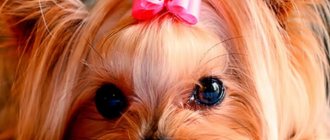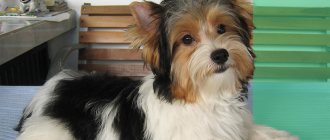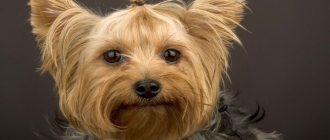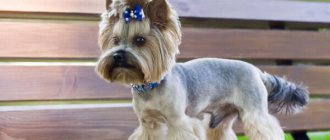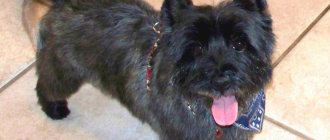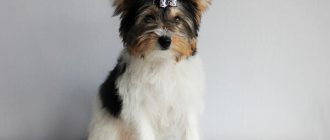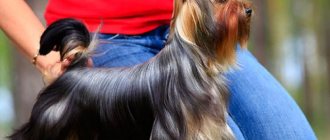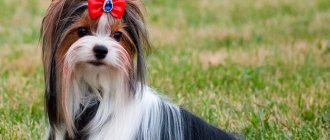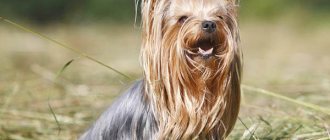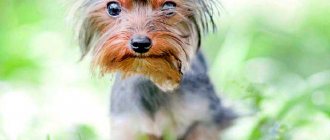The Yorkshire Terrier is a small breed of dog that is perfect for indoor living. The characteristics of Yorkies, their size and appearance affect their care and feeding. When keeping terriers, it is important to learn how to trim nails and fur, and care for the eyes.
The popularity of these miniature companion dogs is steadily growing. In our age of insane speeds, general alienation, lack of communication with an abundance of emotional overload, the small charming Yorkshire terrier becomes for a person a source of vital energy, a feeling of closeness and joy from communicating with a friend who is always nearby.
Yorkshire Terrier breed standard
The canonical types of Yorkshire terriers were established back in 1898, then supplemented in 2009:
- A long-haired dog, without down, so the hair falls evenly.
- The posture is compact and graceful, the body is strong.
- The head is small, without a prominent nose.
- Scissor bite.
- The ears are erect and covered with fur.
- The paws are straight, both the front and rear legs are straight, the shoulders are regular and symmetrical.
- The tail is docked or undocked. The latter is as straight as possible and complements the line of the back. And the docked one is worn a little higher. Both options are considered acceptable.
Varieties of Yorkshire terriers exist only among breeders experimenting with the size of their pets. The standard adopted in the CIS countries in 1988 does not define a minimum weight limit, setting only a maximum of 3.1 kg.
Perhaps you will be interested in reading about the most unusual cat breeds? Then follow the link https://porodakoshek.ru/porody/top-20-redkix-porod-koshek-opisanie-foto-i-stoimost.html.
Rock defects
Yorkies with:
- semi-erect ears;
- underbite or underbite;
- non-standard color;
- cryptorchidism.
Defects also include too bulging or incorrectly set eyes, defects in the structure of the paws, lack or modification of teeth, a short or long massive neck, and a low-slung croup. It is noteworthy that animals that are not gaining weight are traditionally not welcomed.
Common diseases
Teeth are one of the Yorkies' weaknesses..
They often have irregular teeth and a tendency to form plaque and tartar, which leads to periodontal disease and tooth loss.
CAREFULLY!
There are frequent cases of conjunctivitis due to a narrow tear duct and hair getting into the eyes.
Another pathology characteristic of these dogs is distichiasis . This disease is characterized by the growth of another row of eyelashes, as a result of which the eyelashes grow inward, injuring the cornea.
If we talk about diseases of the musculoskeletal system, then most often Yorkies are diagnosed with Perthes' disease, in which the head of the femur is destroyed, which leads to lameness.
The first manifestations of the disease are observed at the age of three months.
Yorkshire Terrier breed large standard
These are the so-called big Yorkies. In fact, this is the optimal size for a small animal. A large Yorkshire Terrier weighs from 2 to 3.1 kg. He has a balance between size, classic appearance and health.
Dogs exceeding the 3.1 kg mark are outside the breed limits. This is not a problem if the “Yorkshire Terrier Maxi” is bought exclusively as a pet and will not participate in exhibitions. But he is not suitable for breeding, since he does not have the canonical weight.
The Great Yorkshire Terrier may appear due to the mating of a large male and female, or due to the mixing of species with another, larger one.
Biro - Yorkie and Shoko - Yorkie
This subspecies also differs from standard Yorkshire terriers in its color - there are no black hairs in the coat.
They are usually chocolate-white in color with golden tints . Also, Biro-Yorks are distinguished by the fact that their size and weight are slightly larger than necessary, so this subspecies is not included in the breed at all.
Recently a Choco-Yorkie was bred, which is not included in the breed standard. From the name it becomes clear that the specificity of the Choco Yorkie is the chocolate color of the coat.
It can be from light milky to dark chocolate . In addition, the color must be uniform.
Yorkshire Terrier mini
Stand out as amateurs. People unfamiliar with the official standards should study all the information about these conventional varieties before purchasing a puppy. Artificially reduced dogs often have genetic abnormalities and diseases from birth that significantly shorten their lifespan.
Mini Yorkie: standard
The main indicator is weight from 1.5 to 2 kg. Such puppies are obtained when a standard female and a small male are brought together. When buying puppies, it is important to pay attention to their condition: unscrupulous breeders underfeed them, achieving miniature size. This affects:
- the already fragile health of Yorkies;
- psychological state of the pet;
- his training abilities.
If standards quite successfully assimilate commands, have a calm and balanced character, then reduced representatives experience difficulties in learning and are aggressive towards others. When getting a dwarf Yorkshire terrier, you should remember that the smaller the dog, the more difficult it is to care for and train it.
Difficulties in caring for a micro Yorkshire terrier
Completely dwarf Yorkies or super minis weigh up to 1.5 kg. These pets are different:
- poor health, problems with the skeleton, internal organs;
- low intelligence;
- short life.
Sure, they look cute, but keeping a Micro Yorkie is very difficult. He must be protected from falls even from a small height; when running, they often break limbs. In addition, due to its low intelligence, the mini Yorkshire Terrier is difficult to train.
Mini and super mini bitches are not suitable for breeding. They are unable to bear and give birth to puppies normally. The temptation to get a dog smaller than a cat is quite strong, but you need to be prepared for serious difficulties.
The smallest Yorkshire Terrier in the world was born in 1945. He weighed only 113 g, but he died after 2 years of life. The height of the withers was 6.3 cm, and the length from nose to tail was only 10 cm. And the title of a modern miniature dog belongs to the Big Boss terrier. His height is 11.9 cm and weight is about 500 g.
How to care
Caring for your Yorkshire Terrier is an essential part of your life together with your dog. The result of proper and careful care is his health, beautiful appearance and your mood accordingly. So, care should include:
- cleaning teeth, ears, eyes;
- nail trimming;
- wool cutting;
- bathing;
- combing;
- oiling wool;
- winding curls of wool onto curling irons.
Video instructions for care principles
Eyes
You need to take care of your eyes daily. In the morning after sleep, be sure to wipe the corners of your eyes with warm boiled water or a solution of chamomile infusion. Use soft cotton swabs to remove any secretions that have accumulated overnight. Excess moisture after wiping the eyes also needs to be removed. After this, the hair around the eyelid is combed with a toothbrush.
Ears
The ears are also wiped with water or a special lotion as the ear becomes dirty. But at least once a week. Let us remind you that unpleasant odor from the ears or dark brown plaque is not allowed. In this case, you need to contact a veterinarian.
Teeth
Your Yorkie needs to have his teeth brushed to prevent tartar buildup. It comes from dog food scraps. To do this, use either special toothpastes with brushes, or use dog treats to clean your teeth; they are usually made from compressed tendons. Failure to take proper care of your dog’s oral cavity can lead to inflammation and bleeding of the gums, and subsequently to tooth loss. Brushing your teeth more often is enough 1-2 times a week.
How to trim claws
Yorkshire Terriers' nails need to be trimmed as they grow. For Yorkies this is usually once every 1-2 weeks. But, if the dog often walks on the asphalt, then the claws will wear down on their own. If you still need to trim, then contact the veterinary clinic for the first trimming. There they will show you how to trim correctly and to what length, so as not to hurt the living (sensitive) part of the claw. Then the procedure can be carried out independently using special nail clippers and files (for sharpening).
Grooming – haircut at home
Yorkies' coats are trimmed with a clipper, scissors and a soft comb. Every 2 weeks, the hair around the anus, under the arms, between the toes and on the tips of the ears (upper 1/3) is trimmed. This is a hygienic dog grooming. This procedure is mandatory for all dogs.
If you are not going to exhibit your Yorkie at exhibitions, then a standard haircut for your Yorkie, which will be done after 2-3 months, is suitable for you. With this type of haircut, the hair is kept neat, gets less dirty and does not require curling into curling irons.
You can cut your dog’s hair either on your own or in a salon. For a model haircut (for show dogs), use the services of grooming salons. Here your imagination can run wild and you can give the dog different shapes (like a poodle or a lion, with pants or with bangs).
How to wash a Yorkshire Terrier
Washing the Yorkshire Terrier is often not allowed. It is advisable only when soiled, but at least 2-3 times a month. From a young age you need to accustom your Yorkie puppy to this procedure. The water should be slightly warmer than room temperature (30 - 35 degrees), the flow of water should not be strong, so as not to scare the baby.
It is advisable to use shampoos special for Yorkies, or for breeds with long, silky hair. It is recommended to dilute the shampoos with water 50/50, rub thoroughly in your hands and only then apply to the dampened coat in the direction of hair growth (so that the coat does not get tangled). Try to prevent water from falling into your ears; you can plug them with cotton balls.
After washing, the shampoo is thoroughly rinsed off and a conditioner or conditioner is applied - a rinse for easy combing (rinse off thoroughly with water). Dry your dog with a terry towel and hair dryer. The air flow should not be hot or fast. Place the fur in the direction of hair growth on the body and against the direction of hair growth on the paws. And we apply a spray - conditioner or oils to soften the coat.
Lubrication with oil is necessary in order to anoint already dry and combed wool. To do this, use burdock, coconut, almond or bamboo oils. You can also use nettle, peach or wheat germ oil. Dilute half a teaspoon of oil in 100 ml of distilled water and apply to strands using a spray. When the water dries, the coat becomes soft, silky and easy to comb.
Winding on papillots. It is produced so that the wool does not get tangled and protects it from excessive dirt and tangles. After the wool has dried. For this purpose, plastic papillots or strips of special (rice) paper are used. The wool is divided into strands (up to 15 strands) and wrapped along the entire length in a paper strip, then rolled up and secured with an elastic band. To ensure that curls do not interfere with a walk, special robes and overalls made of natural silk are worn. The dog walks like this until the next bath. But this is an option for show Yorkies.
Combing
To properly comb your Yorkie you need:
- massage brush with natural bristles
- metal massage brush with antistatic coating
- comb with rotating teeth
If you do not curl the wool into curling irons, the coat must be combed daily. If tangles have formed or your hair is very tangled, first smooth it out with your hands and only then with a comb.
Which Yorkie is better: standard or mini?
Due to the great demand for dwarf breeds, their price is rapidly increasing. However, professional breeders recommend choosing a pet from 2 to 3 kg, i.e. large standard. It has significant advantages:
- health and normal immunity;
- possibility of breeding;
- learning ability;
- he is recognized at shows in the classics of the breed.
He gets along well with children and other dogs. Miniature puppies also appear in standard-sized Yorkies. But breeding them on purpose is a risky and unjustified activity.
Breeds are already degenerating due to selection: modern terriers are much sicker than they were 100 years ago. Therefore, when choosing a pet, it is advised to choose recognized standards so as not to be disappointed by the short life of the dog.
Key points in training
- First of all, the puppy needs to be taught that the person in charge in the house is the person . Otherwise, the pet will begin to manipulate all household members. He must know the feeding and walking schedule, know where the places for sleeping, eating and toileting are.
- By 3-4 months, the pet will have learned its name well, then you can learn the basic commands: “near”, “place”, “no”, “sit” and “quiet”. At this age, communication skills with other people and dogs should be instilled.
- A little later (7-12 months) you can start training the puppy in agility (obstacle course) for short dogs. Rough methods of education are not acceptable. Yorkies are quite capable, they need to explain the task and lure them with a treat. All training should be done through play.
Read about how to properly train a dog in the article: “Training a puppy: effective methods from dog handlers, learning commands at home.”
Historical reference
Today, the Yorkshire Terrier dog is perceived as a decorative pet that accompanies its owners everywhere. Luxurious fur and a charming face are the result of careful selection and breeding, but the Yorkie's disposition is directly related to the history of the breed. By the way, the origin of Yorkshire Terriers is shrouded in darkness and fog. This is not surprising, considering that the first breeders were illiterate commoners limited in literally everything.
So, let's move to the north of England in the 17th–18th centuries. The English nobility, amusing themselves with dog baiting and mass hunting, the poor, living from crumb to crumb. The popularization of hunting led to the extinction of large wild animals, but the monarch’s retinue could not be left without their favorite pastime. A law was introduced in the country banning the keeping of large dogs by the lower strata of the population. Yorkshire, a county in the north of England, was literally infested with rats and mice, and their population was supported by fairly developed agriculture and the absence of a “natural counterbalance.”
Cats were unpopular due to their perceived uncleanliness. Mustachioed tabbys were burned alive at public events, considered to be accomplices of evil. While the purrs were taking the tenth route around Great Britain, the rodents were not only destroying supplies, but also threatening human health. For farmers, the only alternative was to keep legal pets. The poor man's dog had to be small in size, or rather, fit into a loop with a diameter of just over 17 cm. Obeying the monarchs, people selected the smallest puppies from litters for further breeding. The law limiting the size of dogs gave birth not only to the Yorkshire Terrier, but also to the well-known Bull Terrier.
This is interesting! Early Yorkies protected the house and supplies from rats, and helped hunt gophers and small birds. The breed even took part in rat-baiting, and dogs that won such difficult fights were considered priceless.
By the middle of the 8th century, the number of small gray-blue dogs had increased significantly. They were called Waterside Terriers and were actively used in targeted hunting of rats, including on water. Practicality and necessity forced dog owners to take their four-legged dogs with them everywhere. The main travel routes followed the coastlines of Yorkshire and Lancashire. Small dogs quickly spread throughout England and its colonies, which played a significant role in the development of the breed.
After the mass migration of the Scots, another breed line of small hunting dogs appeared in England. Despite the obvious differences among the four-legged animals living in the mountains, on the plains and swamps, the entire breed line was united by one name - the Scotch Terrier. Three breeds that were part of the line participated in the breeding of Yorkies: the Paisley, Clydesdale and their descendants, the Manchester Terriers.
Huddersfield Ben is the “father of the breed” and the first dog to be officially named the Yorkshire Terrier. The manufacturer was born in 1865 and sold to Yorkshire. According to reports, Ben was still the same descendant of Scotch Terriers. The renaming to Yorkshire was a tribute to the region, which played a key role in the breeding, improvement and establishment of the breed. Ben sired many elite sires and champions, won 74 awards and was tragically killed by a horse-drawn cart.
This is interesting! International recognition of Yorkies “started” in America, when in 1872 the breed standard was adopted by the AKC (American Kennel Club). Today the breed is recognized and widespread throughout the world.
Owner reviews
Before Alphonse came into our family, I had experience with Yorkies. When I was 15 years old, my parents agreed to buy a small furry baby. He was only 2 months old and was a very cute little licker. True, he had one problem - I never taught him to do his business in a diaper. We walked a lot with him, and I am irresponsible about vaccinations. And so he fell ill... It turned out that he had a virus - enteritis. Despite the fact that he was treated, they gave him IVs, he burned out in 5 days and it still hurts me to remember him...
I have a happy story with Alphonse. Firstly, he appeared in our family when I became an adult and I already had a child. The only health problem we have encountered is cryptorchidism. But we did not do the operation. Our shaggy miracle is already 5 years old, and he gets along well with the Chihuahua. We used to go for walks often - 4 times a day, now less often - 2 times. We feed him Royal Canin for small breeds. This is a family favorite.
Valentina, Rostov.
I have lived with large dogs all my life. My parents had a Doberman Pinscher and my grandmother had a German Shepherd. When we got married, my husband and I also decided to get ourselves a dog, but since the apartment was rented, we had to forget about a large breed. Then I decided to buy a Yorkie. One of my friends bought a pet for herself, but after 2 months she gave it to her mother, who was very reluctant to accept such a new addition to the family. I already bought 7-month-old Chucky cheap. It was an unfortunate creature - its ears drooped, its claws curled into rings. At the veterinary clinic they helped us put the ears on and now he is an unrecognizable dog. He turned out to be very smart and absolutely non-aggressive. He loves dogs very much and runs towards them, wagging his tail in a friendly manner. We have to stop him. We train our Chucky and he quickly learns commands. An ideal pet that you can take with you on a visit without any problems. He really doesn't like to be left alone and howls in anguish. We have to turn on the TV for him so that he doesn’t feel so lonely.
Amelia, Belgorod.
Yorkshire terrier puppy
Coat
The Yorkshire Terrier's long, completely straight coat, free of any curl or wave, is non-fluffy and flows down the sides of the Yorkshire Terrier. It is evenly parted on the back. The coat should be fine and silky to the touch.
Moving away from the topic of the Yorkshire Terrier standard, it is worth noting several important facts.
The fur of dogs of this breed resembles human hair. It grows all the time and rarely falls out. An adult Yorkshire Terrier, whose height varies from twenty to twenty-five centimeters, grows fur at a rate of approximately fifteen millimeters per month.
To prevent damage to the animal's hair while combing, it is necessary to choose the right comb. You need to purchase a comb with natural bristles for regular combing, as well as a metal comb for carefully combing out tangles that spoil both the appearance and structure of the coat.
Under no circumstances should you use a slicker comb, otherwise you may damage the delicate skin of your Yorkshire Terrier.
